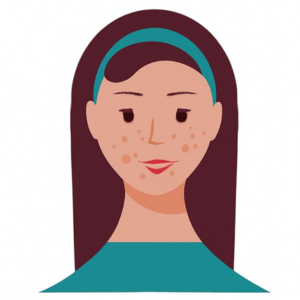
Acne-prone Skin: Inflammatory, Cyclical, Highly Individual
Not every pimple is preventable. But every flare-up has a story
Acne is not a flaw. It’s a condition—and it has context.
Acne-prone skin isn’t always oily—and it isn’t always consistent. It may cycle through periods of calm and flare, triggered by hormones, stress, skincare mismatches, or internal factors. This skin type requires observation, patience, and strategic support—not harsh products or quick fixes. With the right care, breakouts can be reduced, and skin can gradually return to clarity and balance.
Traits and Characteristics
What defines this skin in daily life?
Acne-prone skin is defined by a persistent congestion and tendency to develop comedones, papules, pustules, or cysts. Breakouts may appear in clusters or isolation, often leaving behind marks or surface texture. This skin type often reacts to hormonal changes, product buildup, and barrier disruption—making stability a moving target.
Skincare
Focus
How should care priorities be organized?
The top priority is to reduce inflammation and prevent future congestion without irritating or over-cleansing the skin. This means choosing actives that support cell turnover, limit bacterial overgrowth, and preserve the skin’s barrier. Long-term consistency is more effective than aggressive treatment.
Skincare
Pillars
Which core practices support skin balance?
Skincare for acne-prone skin includes gentle, pH-balanced cleansing, lightweight hydration, and regular use of acne-targeting actives like salicylic acid, azelaic acid, or retinoids. Sunscreen is essential to prevent pigmentation from healing blemishes. Barrier support is equally important, especially when using multiple actives.
Format
Navigator
Which product formats work—or don’t?
This skin type often does well with light gels, gel-creams, fluid emulsions, and thin lotions. These allow actives to penetrate while minimizing residue. Thick balms, heavy creams, or oil-rich products may worsen breakouts, especially in occluded areas. Aim for lightweight, fast-absorbing, layerable formats with a clean finish.
Ingredients Navigator
Which ingredients align—or cause issues?
Helpful ingredients include niacinamide, salicylic acid, azelaic acid, zinc, green tea extract, and non-comedogenic hydrators. Avoid pore-clogging oils, heavy occlusives, and known irritants like denatured alcohol or strong fragrance. Barrier support ingredients like panthenol and allantoin reduce irritation from treatment-focused routines.
Keep Going—Your Skin Is Listening
Acne-prone skin can be frustrating—but it’s also a communicator. Breakouts are not a failure; they’re a signal. With observation, consistency, and the right support, patterns become clearer and setbacks become less frequent.
The goal isn’t flawless skin—it’s calmer, more stable skin over time.
Want to explore other skin types? Return to the skin types landing page and restart your journey into different skin types from there.
Back to skin types overview
Want to understand your skin in depth? The Skin Types Decoded book is where this journey began—and it will guide you far beyond the basics.
From Skin Types Decoded
Visual learner? The upcoming flagship course takes you step-by-step through skin behavior, care logic, and long-term personalization.
Coming soon